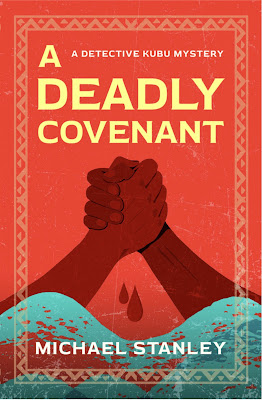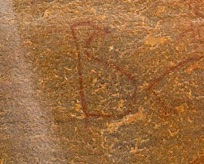Stanley - Thursday
We are about a month away from the launch of our eighth Detective Kubu mystery, titled A Deadly Covenant. The book starts with the discovery of several skeletons of Bushmen who had been murdered and buried in the sands of the Kalahari.
Bushmen have played a major role in a number of our books. In A Carrion Death, it is Kubu's Bushman friend Khumanego who teaches him to be observant. The backstory of Death of the Mantis is about the demise of the Bushmen and the need of the remaining ones to maintain their history and traditions. In Dying to Live, a dead Bushman is found in the desert in suspicious circumstances. His body is sent to Gaborone to undergo a postmortem. Although the man is clearly very old, the pathologist finds that his organs are young, and a bullet lodged in his abdominal muscles has no entry wound. This leads to a frenzied belief that he has discovered a plant that prolongs life.
One of the reasons Bushmen play a prominent part in our books is that we have a great admiration for them and an extreme distaste for how they've been treated. For example, it was only in the 1930s that hunting licenses were stopped being issued for hunting them.
"That will be sixpence for the kudu, sixpence for the gemsbok, and thruppence for the Bushman," one can hear the clerk behind the counter say.
There are many things that have attracted us to the Bushmen. Here are some of them.
Bushman poisons
There are a number of poisons that the Bushmen use for hunting. The most intriguing is the poison from the Diamphidia nigroornata beetles which lay their eggs on the stems of shrubs from one of the Commiphora trees in the frankincense and myrrh family.
They then cover the eggs with their own faeces, creating a hard shell when dry. Eventually the larvae shed their protection and burrow up to a metre into the sand next to the tree, where they make a cocoon from sand. It may take several years before they molt into pupae.
 |
| Larva in its sand cocoon |
The Bushmen dig up the larvae and pupae and gently squeeze the liquids in them into a container. When they are ready to hunt, they apply the poison, not to the tip of the arrow in case they nick themselves, but rather to the base of the arrowhead. The poison is important because the bows and arrows Bushmen use are very flimsy and unable to kill an animal outright.
The poison causes partial paralysis and labored breathing, followed by cyanosis and respiration ceasing. Since the poison takes time to bring an animal down, the Bushmen sometimes have to follow a large animal, such as an eland, for days. The the animal falls, the Bushmen kill it if not already dead, and cut up the meat.
They can then eat the meat without dying from the poison.
Several things about this astonish me. First, how did the Bushmen eons ago discover the larvae buried so far underground? Second, how did they figure out that the liquid inside the larvae were toxic? Finally, how many Bushmen died before they figured all this out?
There are a lot of other side issues that are interesting. Because the hunted animal often runs through scrub and bush, and because resources in the Kalahari are few and far between, the arrows that Bushmen use have two parts: the head with the poison; and the shaft. When an animal is hit and start running, the main shaft falls off and is reusable. The part with the poison remains fixed in the animal and is retrieved when the animal collapses. (Surprisingly, the arrow also doesn't have flights.)
 |
| Arrow shafts and detachable arrow heads |
 |
| Poison container, pointed to stand in sand |
Navigation
In the northwest of Botswana is a range of hills that rise abruptly out of the desert, known as Tsodilo Hills.
 |
| The Tsodilo Hills in the Kalahari |
The Bushmen regard this as the birthplace of humankind. Today it is a World Heritage site boasting thousands of rock paintings, some of which go back thousands of years. I've had the good fortune to visit it several times.
Two paintings always astonish me: one of a whale and one of a penguin.
I've no idea.
Lack of jealousy
The Bushman were very worried about jealousy. If someone made or found something that was beautiful, they would give it away rather than keep it. Jealousy, they believed, was the cause of friction. And friction in an environment like the desert would only lead to disaster.
There's a wonderful movie about jealousy among the Bushmen. I watched it when I was a kid. It is called The Gods Must Be Crazy. it is worth finding and watching, even though some of it is dated. It is all about a Coke bottle.
Most of us would struggle to survive in the harsh climate of the Kalahari Desert. Yet the Bushmen have been doing it for tens of thousands of years.
How?
First, the nomadic groups were usually very small, usually no more than a dozen or so. This meant that no group had to find a lot of food at any one time in order to survive. Second, they knew where to find food, sometimes buried, and water, even though there were no neon signs and signposts.
 |
| Tsama melons growing wild in the Kalahari |
And third - and perhaps the most important - was that they never finished any resource no matter how badly they wanted it. So, even if a group was very thirsty and they came across a small amount of water, they never finished it, always leaving something for the next group.
This was because there was no such thing as ownership. Everything belonged to everyone, and therefore had to be shared. We could certainly learn from that (and from the lack of jealousy).
However, when ownership came to the territories in which they lived, that was when problems started. Farmers, Black and White, arrived owning cattle, for example, and land. The Bushmen would come across a cow. It was much easier to kill it, because it didn't run away, than to run for several days after an eland. The farmer thought differently and would either kill or enslave the Bushman if he caught him.
And that was the beginning of the end. Today there are probably no nomadic Bushmen left.
_________________________________
September events:
Thursday 8.
Launch of A Deadly Covenant
Wednesday, 7. 4:30 – 5:30 pm
Totally Criminal Cocktail Hour at Valley Bookstore
The Zephyr Theatre, 601 N Main St, Stillwater, MN 55082
Find out more about the event HERE.
Thursday, 8, 4:15 – 5 pm
BOUCHERCON Panel:
Multi-Tasking is Murder – Juggling Multiple Series ( How these authors create and balance multiple series at the same time.)
Chris Aldrich (Moderator); Michael Sears (Michael Stanley); Sujata Massey; Julie Hennrikus; Laura Childs/Gerry Schmitt; Anna Lee Hube
Friday, 9, 1:45 – 2:30 pm
BOUCHERCON Panel:
The Mystery of Multiple Points of View and Multiple Timelines (Writers use dual perspectives/multiple narrators and alternating timelines to tell their stories.)
Marty Ambrose; William Boyle; Mary R. Davidsaver; B.A. Shapiro; Julie Carrick Dalton; Stanley Trollip (Moderator)
Saturday, 10, 11:30 -12:15 pm
BOUCHERCON Panel:
Under the Sun or Below Zero (You’ve heard of “setting as a character.” Well … what about the weather? These authors’ works represent a dichotomy of climates where rising temps or bone-chilling cold are just as effective as any villain.)
Alexander McCall Smith; Stan Trollip (Michael Stanley); Catriona McPherson; Jo Nesbø ; Matthew Goldman (Moderator); Caro Ramsay
Thursday, 15, 12:30 – 1:00 pm (UK time)
Virtual event at the International Agatha Christie Festival
Agatha in Africa
Michael, Stanley and Zimbabwe author Bryony Rheam discuss Agatha Christie’s trip to South Africa and Southern Rhodesia and its connection with her mystery thriller The Man in the Brown Suit.
Monday 19, 6:00 pm
Nokomis Library event
5100 S 34th Ave, Minneapolis, MN 55417 Phone: 612-543-6800
Wednesday 21, 6:00 pm
Thomas St. Angelo Public Library of Cumberland event
1305 2nd Ave, Cumberland, WI 54829. Phone: 715-822-2767
Thursday 22, 6:30 pm
Spooner Library event
421 High St, Spooner, WI 54801 Phone. 715-635-2792
Saturday 24, 1200
The Bookstore at Fitger’s
600 East Superior Street, Duluth MN 55802
Tuesday, 27, 6:00 pm
Launch of A Deadly Covenant at Once Upon A Crime
604 W. 26th Street, Minneapolis, MN 5540 Phone: 612.870.3785 Email: onceuponacrimebooks@gmail.com
With Mary Ann Grossman
October events:
Saturday 1, 9:00 am – 3:00 pm
Meet us at the Deep Valley Book Festival
Mankato, MN
Free book festival. We’ll be there from 9am to 3pm. The event takes place at the WOW! Zone, conveniently located at 2030 Adams Street in Mankato, just off Highway 14.
Thursday 6, 7:00 pm
Barnes and Noble HarMar
2100 Snelling Ave N, Roseville, MN 55113
Saturday 8.
The Poisoned Pen Bookstore
4014 N Goldwater Blvd #101, Scottsdale, AZ 85251 Phone:(480) 947-2974 Toll Free: (888) 560-9919 Email: sales@poisonedpen.com
Michael and Stanley join Barbara Peters on Saturday afternoon to chat about A Deadly Covenant.
Friday, 14, 10 am
Lake Country Booksellers event
4766 Washington Ave, White Bear Lake, MN 55110 Phone: 651-426-0918
Saturday, 15, 10:00 am – 5:00 pm
Twin Cities Book Festival
Minnesota State Fairgrounds, Saint Paul, Minnesota




















Thanks, Stan. I find the various niches to which humanity has adapted, and the cultures that spring therefrom, entirely fascinating.
ReplyDeleteI loved "A Deadly Covenant." Loved, loved, loved it.
ReplyDeleteThank you!
DeleteThank you for sharing the bushmen stories and congratulations on A Deadly Covenant!
ReplyDelete